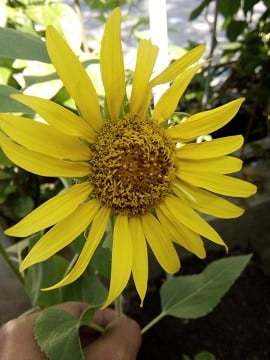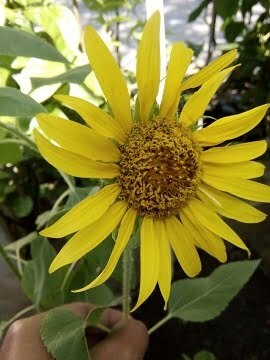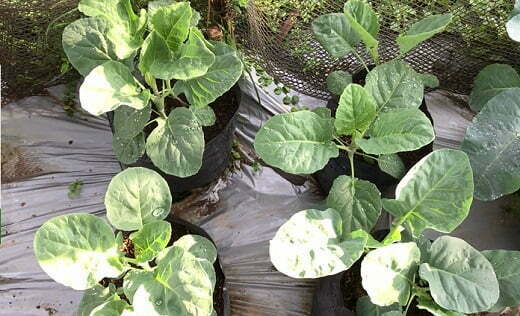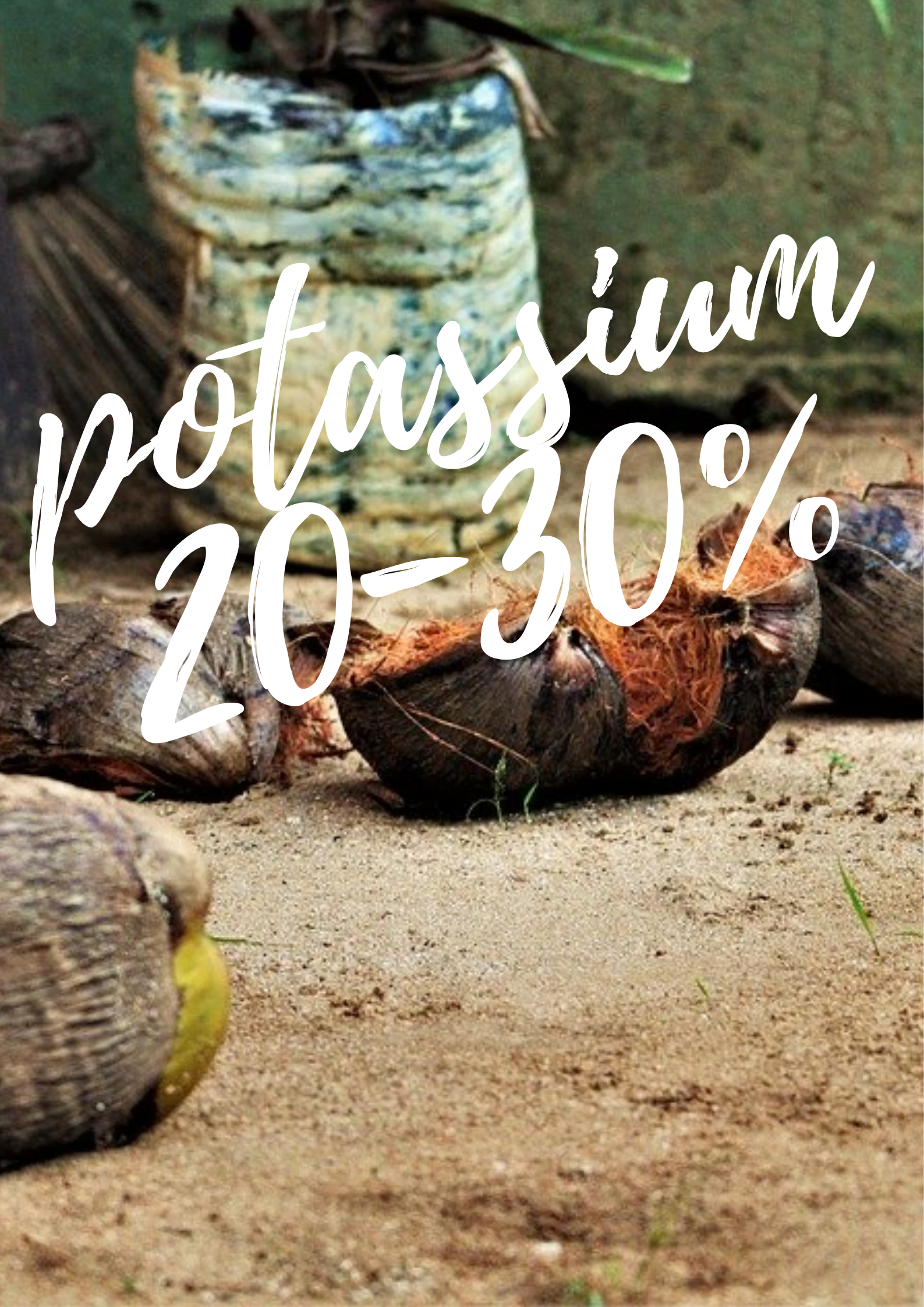How to plant sunflower in pots is not difficult. I have planted it myself and the sunflowers I planted have succeeded until they flower. I will share in this article how to plant sunflowers in pots in more detail. Please continue reading.

Besides that, the treatment that I did was almost instantaneous. Out of focus because there are many plants to watch out for.
Even so, the sunflowers I planted grew quite well. That could be a sign that this sunflower is not fussy.
Technically, how to plant sunflower in pots is easier because of these two things.
- Large seed size
- Simple fertilizer
Big seeds, big sprouts too.
Large seed sizes are easier to handle one by one. In contrast to the very small seeds of daisies or chrysanthemums. Requires more patience in handling.
As for fertilizer, we can only use NPK fertilizer. I think we can use NPK fertilizer, whether 15-15-15 or 16-16-16.
We are not growing fruitful crops such as melons, chilies, tomatoes, or long beans for which micro-macro nutrients are really available.
This doesn’t mean that sunflowers don’t need nutrients like calcium or magnesium. He needs it, but for a hobby, NPK is enough in my opinion.
Only if you want sunflower cultivation seriously, so that seed yields can be maximized, fertilization programs can be worked on more seriously.
Facts about sunflowers
For the most part, people grow sunflowers for ornamental plants only. Because of the large petals and cool flower shapes.
But more than that, there are several benefits that we can take from sunflower parts.
Certain parts of sunflower can be anti-cancer. Later we will discuss the preliminary research.
Sunflowers belong to the Compositae family. There are many species, about 67. But only a few are commonly cultivated.
Sunflowers are both self-pollinating and cross-pollinating. The cross-pollination rate is between 17 and 62%. [1]
Sunflower seeds do not ripen simultaneously. The process of forming the seeds starts from the edge of the flower plate so that the seeds that are located on the edge of the flower cup reach maturity first.
There are two types of sunflower seeds. Namely, sunflower seeds produce oil (oilseed sunflower) and seeds that do not produce oil (non-oilseed sunflower).
Sunflower oilseed is black and flatter. Meanwhile, non-oilseed sunflower is thicker, has black-and-white-striped seed skin, and lower fat content. [1] This is what we usually eat.
Step by step how to plant sunflower in pots
Some of the steps for planting sunflowers in pots are preparing the planting medium, sowing seeds, grooming, and waiting.
It takes us at least 60 days for sunflowers to start blooming. Must be patient and painstaking.
Growing media for planting sunflowers
Use a planting medium that consists of at least two types of growing media. This is so that the level of water absorption and soil compaction is balanced.
If it is only soil, the longer the planting medium will be tougher and denser. What’s more, avoid using clay.
Soil is very good when mixed with compost, sand, husks, or burned husks.
1: 1 ratio, can make media good in the long run and not compact quickly.
Single planting media other than the soil can use cocopeat or burnt husks. It is cleaner and less messy but will be watered more frequently because of the less able to hold water.
Especially for compost, especially (cow, goat, or chicken manure compost), media preparation and mixing are done at least 2 weeks before planting.
To ensure that the compost is ready, the sign is that weeds have started to grow.
If necessary, each pot is given 5 grams of finely ground eggshells. This can be a source of organic calcium and magnesium. Because if fertilization only uses NPK, the elements of Calcium (Ca) and magnesium (Mg) will be deficient.
Sowing sunflower seeds.
These are sunflower seeds. I bought sunflower seeds because I didn’t have sunflowers before.
So that way, the chances of failing to grow are less.
Flush the media in a pot that is ready with water.
Fill each pot with one sunflower seed. Make a hole about 2 cm, cover it with planting media.

Give Water every day to keep the planting medium wet.
Within 2 days, the seeds will start to sprout.

It can also be filled in one pot with more than one sunflower. I filled it with 2 seeds.
No problem, sunflowers are still growing well. But watering should be more frequent and fertilizing should be more.
Because the need for water and fertilizer for 4 plants is definitely more than just one plant.
In about 2 months, we can see sunflowers that have started to bloom.

Sunflower care
Things that must be done in caring for sunflowers are:
- Flush
- Apply fertilizer
- Remove the pest.
Watering plants is a mandatory activity. Because without water the plants will die. Do it every day or when the planting media is about to dry.
A sign of a plant lacking water is wilted leaves. Flush immediately when it shows signs of wilting.
Fertilizer for sunflowers.
If we use soil growing media and manure with a ratio of 1: 1, then fertilization for the vegetative phase can be postponed.
Until the sunflowers begin to flower, then additional fertilizer can be applied.
The type of fertilizer that can be used is NPK fertilizer which can be 16-16-16 or 15-15-15 or AB mix flower fertilizer.
Fertilizer application can be done once a week.
For NPK, every 2 grams is dissolved in 1 liter of water. One pot, given one glass.
Or it can be done this way. Give a pinch of NPK for each pot. Sprinkle NPK on the edges of the pot, not too close to the sunflower stalks.
Sunflower pests
I’m not sure that growing sunflowers in pots will bring in a lot of pests. Because the number of plants is only a little.
Pests come to find food and breed for their survival. If there were not too many sources of food, it was unlikely that a large number of attacks would occur.
Some do exist, such as grasshoppers. And pests from other host plants are also likely to drop by sunflowers.
Pests from plants such as chilies, tomatoes, and eggplants as well as several types of vegetables can affect sunflowers.
The list of sunflower pests and diseases is extensive. As an additional insight, we will discuss it one by one.
1. Grasshopper
Grasshoppers do not directly damage sunflowers. But eating the leaves. The leaves will be perforated and leave an imprint of the grasshopper’s bite.
2. Green ladybugs
The green ladybug called Nezara viridula is one of the main pests of sunflowers. It attacks sunflower seeds and the attack occurs in the flowering phase.
Symptoms of an attack are deflated seeds.
This cycle of ladybugs from egg to adult takes 4-8 weeks.
One imago (female ladybug) can lay up to 90 eggs per tail.
The proper control method to suppress the development of these pests can be done by collecting eggs and the nymphs then destroying them. The method of biological control was carried out by utilizing egg parasitoid wasp Ooencyrtus malayensis (Ferr.) And Telenomus sp.
3. Corn cobs caterpillar
The corncob caterpillar named Helicoverpa armigera is also a major pest in sunflower plantations. Apart from the sunflower field as the host, this pest can also attack corn, tomatoes, tobacco, cotton, potatoes, jatropha, and various other vegetable crops.
This pest attack is very massive. Because per head can produce up to thousands of eggs. Then these pests will suck the honey from the plant flowers.
Attacks appear when sunflowers begin to flower. Because high protein sun seeds will be good food for these corn cob larvae.
The development of eggs to maturity takes ± 35 days.
The method of biological control can be done by using natural enemies, namely the egg parasitoid Trichogramma nana, the larval parasitoid Eriborus argenteopilosa, and the fungus Metharizium.
The method of chemical control that has been reported is the use of insecticides with active ingredients of sipenmetrin and monocrotophos.
4. Armyworms
The armyworm, Spodoptera litura, is physically almost like a corncob caterpillar. When they grow up they will become planthoppers (we call it that).
The difference is that the corn cobs attack sunflowers during the generative phase (flowering) if the armyworms attack during the vegetative phase.
So, what is eaten and attacked by armyworms is mainly the leaves. But it did not rule out the flower could also be attacked.
5. Leaf planthopper
The leafhopper, Amrasca biguttula biguttula, is a yellowish-green leafhopper with a pair of black patches on the top of the head and the tip of the wings.
This planthopper is quite small because it is only about 2.5 mm in size.
This planthopper is active at night while it will hide on the underside of the leaves during the day.
Actually, several other pests can attack sunflowers.
But take it easy, not all of the pests above will attack. At least only a few.
For hobby and home scales, the grasshopper is the most common.
We need to know that pests from chili, tomato, eggplant, and their families can move to sunflowers.
Especially when sunflowers start to flower, they will be very attractive to various types of pests. The average opt will place their eggs in places that have high protein.
For larvae to develop quickly and well, they need a diet high in protein.
The parts of high protein plants are the seeds (long beans, soybeans, seeds) and young leaves.
Sunflowers are useful for
Sunflowers have many excellent benefits for many purposes. This is because, in every part of this flower, active ingredients have specific functions.
In full, we can see it in the table below.
| Sunflower section | active ingredients | Useful |
| Flower | Quercimeritrin | antipyretics, hypotension, lowering blood pressure, reducing pain (analgesics), menstrual pain (dysmenorrhea), gastric pain, headache, toothache, stomachache, high blood pressure, inflammation of the breast (external medicine), inflammation of the joints (external medicine), cosmetics (preventing premature aging), and difficulty giving birth. |
| Flavon glycoside | ||
| Sianidinmonoglukosida | ||
| Xantofil | ||
| Kholina | ||
| Betaine | ||
| Sapogenin | ||
| Helianthosida A-B-C | ||
| Oleanolic acid | ||
| Echinocystic acid | ||
| seeds | Globulin protein | Anti-bloody dysentery, arousing appetite, lethargy, headaches, stimulating the release of body fluids (hormones, enzymes, etc.), and stimulating the production of measles. |
| Albumin | ||
| Glutolin | ||
| Essential amino acids | ||
| Beta sitosterol | ||
| Prostaglandin E | ||
| Chlorogenic acid | ||
| Quinic acid | ||
| Phytin | ||
| 3,4-benzopyrene | ||
| Marrow stems and receptacles | hemicellulose | Stimulates energy vitality, calms the liver, stimulates urinary excretion, relieves pain during urination, gastric pain, blood urine (hematuria), fatty urine (chyluria), gastric cancer, esophageal cancer, and malignant mole. hemicellulose can inhibit sarcoma 180 and Ehrlich ascitic carcinoma in mice. |
| Leaves | Anti-inflammatory, analgesic, antipyretic, anti-inflammatory, relieves pain, and anti-malaria | |
| Roots | Anti-inflammatory, analgesic, antitussive, diuretic, cough, kidney stones, bronchitis, leucorrhoea, anti-inflammatory, urine laxative, cough reliever, and pain relief. |
Note: The above active ingredients do not specify that each has a function as in the benefit column.
Between the active ingredient data and benefits is separate information. Although there is one active ingredient that has a function in the benefit column, it needs further discussion and information.
The table above does not provide information on how to cultivate part of the sunflower for the benefits listed in the benefits column.
So, to make sunflower a medicine, you need to look for more references. If necessary, consult medical personnel or experts.
I think it will be here first for how to plant sunflower in pots and some important information related to this type of flower.
Thank you and see you later.
Reference
[1] Khotimah. 2007. Characterization of Growth and Development of Various Sunflowers (Helianthus Annuus L.). Department of Agronomy and Horticulture, Faculty of Agriculture, Bogor Agricultural University. # how to plant sunflower in pots
[2] Laela Nur Rahman. 2010. Inventory of pests and diseases of sunflower plants (Helianthus annuus LINN). Department of Plant Protection, Faculty of Agriculture, Bogor Agricultural University. # how to plant sunflower in pots
[3] Nasruddin. 2013. Cytotoxic Potential of Sunflower Stem Extract (Helianthus annuss L.) Against Colonic Cancer Cells HCT 116. Department of Biochemistry, Faculty of Mathematics and Natural Sciences IPB Bogor. # how to plant sunflower in pots
 JOYNIM FARM Goat Farming, Cattle Farm, Laying Hens, Quail Farm, Gardening
JOYNIM FARM Goat Farming, Cattle Farm, Laying Hens, Quail Farm, Gardening









